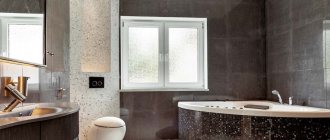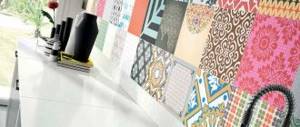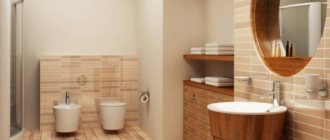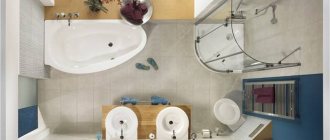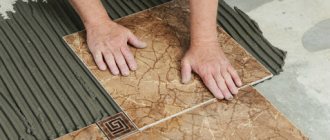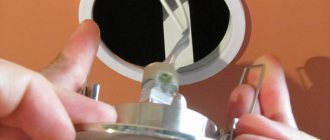Causes of plaque formation
The surface of the tiles in the bathroom is constantly exposed to water, soap solutions, and cosmetics. The liquid part evaporates, the drops dry out, leaving stains of salts, lime and other substances dissolved in water on the shiny tile.
It is not difficult to clean the tiles from dirt: water-soluble salts are wiped off with a sponge or rag. But in some cases, stains cannot be removed. The reasons for this may be:
- increased water hardness: after the moisture evaporates, insoluble lime compounds remain, which form white stains on the tiles;
- leaking taps: they stain the wall with rust, and after the drops dry, the yellowness is difficult to wash off;
- mold fungi: colonize tile joints, constantly appearing on the surface in the form of dark spots resembling dirt, and an unpleasant odor appears in the bathroom;
- consequences of the repair: drops of lime, paint, putty or grouting materials are easily washed off until completely set (within 24 hours), and after that they are more difficult to remove.
Washing tiles in the bathroom.
Recommendations
A few recommendations to help avoid limescale and stains:
- The ceramic surface can be wiped with a sponge, only with the soft side, do not use an abrasive surface!;
- Use all methods that will allow you to reduce humidity in the bathroom;
- Treat the tiles at least once every 2 weeks with a special product;
- Do not use a wire brush for cleaning;
- You should start washing the tiles from the bottom and rinse off from the top.
If you regularly clean your bathroom, there should be no problems with cleanliness. If such a problem is urgent, you need to choose a cleaning product either from improvised ones or from household chemicals. You can also contact professional cleaning organizations specialized in cleaning.
Article Rating
General cleaning recommendations
You need to choose a cleaning agent to remove stains from tiles depending on the type of coating (tile, plastic, terracotta, etc.), as well as taking into account the type of dirt. Fresh stains of any origin can be easily wiped off with a soap and soda solution. Soda, as a soft abrasive, can even cope with rust or lime salts. But old stains will have to be removed with aggressive household chemicals.
Washing tiles with soap and soda solution.
To prevent damage to the wall covering during cleaning, you must follow the following rules for caring for it:
- when using acid-containing chemicals, protect tile joints;
- do not use hard metal sponges and brushes, do not scratch stains with a knife;
- It is better to choose thick gels;
- It will be possible to wash the tiles without streaks only by thoroughly rinsing the surface;
- After treatment, mirror glass tiles must be wiped with window cleaners until they shine.
Modern means
How to clean tiles using modern means? There are many products for cleaning bathroom tiles in the store markets. Bamboo or microfiber napkins will help you clean the tiles - they do not leave streaks, stains, or dirt on the surface being cleaned, and they cope with plaque and dirt. The tiles shine after using them.
How to clean bathroom tiles without gels and liquids? Melamine sponges are a way to remove dirt without detergents. These devices contain colorless melamine crystals, which turn into foam when exposed to water. Dense foam removes even heavy dirt and also saves on cleaning products.
Home Remedies
Improvised products are used in emergency situations, when you need to wash away dirt, but it is not possible to buy a suitable product. Limescale removal is carried out using acidic solutions:
Vinegar and lemon juice remove limescale from tiles.
- Vinegar dissolves traces of water droplets and will help remove grout or lime stains. Table varieties should be diluted with water 1:1, and for essence use 1 tsp. for ¾ glass of water. Soak a cloth in the solution and wash the tiles, rinse and wipe.
- Lemon juice or acid solution works in the same way as vinegar. You can use pure lemon juice or an acid solution of 1 tsp. for 1 glass of water.
You can remove cloudy deposits from drops of soapy water on the lining near the sink and bathtub using baking soda: moisten the powder, apply it to a sponge and wipe the wet wall. Rinse off the remaining soda with plenty of water so that there are no streaks from the powder itself.
An old toothbrush is useful for cleaning tile seams, joints in corners and other hard-to-reach places. It is convenient to treat smooth walls with a sponge. For wiping dry, rags made from natural fabrics are suitable.
Clean tiles in 5 minutes
It is known that the chemical industry does not stand still and the shelves of household chemical stores are full of offers of super products that, in a matter of minutes, cope with the unpleasant consequences of grease deposits and remove limescale deposits that appear after water rich in minerals has dried on a tile.
And over time, the tile “for some reason” begins to lose its rich shade, barely noticeable fragments appear on the glossy coating, which then, in the process of peeling, completely spoil the appearance of the entire surface of the tile.
Aggressive chemicals are not pests in themselves. They saved many housewives from irreparable pollution and forced repairs. Incorrect ones can cause damage to ceramics once and for all:
- application;
- dosage;
- timing of use.
Therefore, more and more housewives are resorting to more gentle “grandmother’s” methods, which, unfortunately, take up a lot of time.
Cleaning tiles using traditional methods
If the use of reliable but caustic chemicals is not possible, you can remove dirt and stains on the walls of the bathroom and bring the tiles to a shine using the folk method. You will need:
- 100 ml hot water;
- 100 g of sound soap shavings;
- 2 tbsp. l. hydrogen peroxide;
- 2 tbsp. l. table vinegar (6-9%);
- 75 g baking soda.
Using a special solution prepared at home, you can give the tiles their former shine and shine.
Dissolve the soap in water, adding it in small portions. Add baking soda powder and leave the mixture for 24 hours. Add the remaining ingredients, moisten the tile with water and apply the prepared mixture. Leave for 5-7 minutes, then rub the seams with a brush, rinse the surface of the wall or floor with a sponge. Finally, rinse thoroughly with water and wipe dry.
An ammonia aqueous solution, which is used to wash glass, will also work well with stains on tiles or other glossy tiles (porcelain, mirror, etc.). Ammonia is used after washing the walls in the bathroom to bring the tiles to a shine. Glass cleaners can be used for the same purpose.
Folk remedies
Every housewife has in her arsenal many available means to combat pollution of any complexity.
- If you have an old dried lemon , do not rush to throw it away, but rather squeeze the juice out of it, dilute it with cold water and wipe the walls and floor in the bathroom. In addition to sparkling cleanliness, you will receive complete disinfection and a pleasant citrus aroma. If there is no lemon, then you can use citric acid by diluting it in warm water.
- Dilute 20 g of vinegar essence in half a liter of cool water and place in a spray bottle. Wet the tiled walls of the room generously, and after a few minutes wipe with a dry cloth. If you use this product every day, mold will never form in your bathroom.
- Ammonia is successfully used to clean window glass and mirror surfaces. It can also be used to clean tiles. Mix 2 liters of cold water with two tablespoons of ammonia. Take a soft cloth, moisten it generously and apply the solution to the wall, leave for a quarter of an hour and rinse with clean water. Then rub the walls with a dry flannel cloth.
- Treat particularly problematic areas with baking soda.. Wet the sponge generously, apply baking soda to it and treat the stains. Be careful not to let the cloth dry, as dry baking soda can scratch the tile.
Dampened baking soda turns into a paste and easily cleans the dirtiest walls. - Use laundry soap to clean tiles. Grate half a piece on a fine grater and dissolve 3 tablespoons in 0.5 liters of hot water. Stir the solution until the soap is completely dissolved and apply the solution to the wall. After a short time, wash the walls with hot water, rinse with cold water and wipe dry.
We should not disdain the recipes for cleanliness known to our grandmothers. - If you just can’t get rid of soap stains on the tiles, then use regular tooth powder . Mix a few spoons of powder with the same amount of water to make a homogeneous paste. Apply this mixture to the wall and let it dry. Then carefully remove from the walls with a rubber or acrylic scraper. Then wipe the walls with a damp cloth.
Specialized household chemicals
Many products only remove fresh dirt well. It is difficult to remove old limescale or rust with them.
Silit Bang dissolves fats and breaks down lime deposits.
At home, it is convenient to use strong but not too aggressive drugs:
- "Silit Bang". Breaks down fats, dissolves lime deposits, and can remove yellow rust stains. The composition is non-aggressive towards all materials used for cladding: it can be used to clean acrylic and various types of plastic, porcelain stoneware, tiles with various surfaces, glass.
- "Mister Muscle". Dissolves soap and lime stains, is easily washed off with water and leaves no marks on different types of wall coverings.
- "Comet". The products are available in the form of sprays and gels with cleaning properties. If you need to quickly wipe clean surfaces to maintain shine, use a spray, but it is more convenient to treat difficult stains with gels.
- Kiilto Clean for tiles. The product contains oxalic acid and is harmless to glossy glazed ceramic surfaces, but can damage gypsum grout.
- "Domestos". Thick gels and sprays have a bactericidal effect. The bathroom will not only be clean, but also safe for health. When mold appears, the tile joints are treated with thick gel.
Domestes rids tiles of mold.
Cleaner
Today, an incredibly wide range of cleaning products is available on the shelves of industrial stores and specialized departments of supermarkets. You should only take from the shelf something that has a label on it that says “designed for cleaning ceramic tiles.” But even if this condition is met, it is worth trying the product in a not too noticeable place.
You can also clean tiles using a melamine sponge. This is a relatively new player in the household chemicals market, but many housewives have already noted its effectiveness. The undeniable advantage of such sponges is that with their help you can efficiently clean medium dirty tiles without the use of industrial products.
If for some reason you are not satisfied with the achievements of the chemical industry, you can always turn to folk remedies. The most common non-core cleaning products suitable for caring for tiles are:
- Dishwashing liquid. Helps fight simple stains. It needs to be applied to a damp sponge, foamed and transferred to the wall. After a few minutes, rinse off.
- Baking soda is a universal cleaning abrasive. But you need to be careful; if you press too hard, it can leave scratches on the glossy surface of the ceramic tile. You can clean the tiles using gentle circular movements.
- Vinegar. Used as a weak solution. Can be applied using a sponge or spray bottle. Helps get rid of mold and stains. You should not use vinegar essence; this product is very concentrated and difficult to dose correctly.
- Lemon acid. This food additive helps fight traces of mold and limescale. The granules should be applied to a damp sponge and the gruel should be lightly wiped over the contaminated areas. A pleasant smell will be an addition.
Melamine sponges can effectively clean medium soiled tiles without the addition of industrial products.
Features of washing different types of tiles
When trying to wipe dirt off tiles, it is advisable to take into account the nature of the surface. On smooth, glossy walls, plaque forms quickly, but it is easy to visually detect and remove immediately. Other types of ceramic tiles need to be cleaned properly to achieve a satisfactory result.
Glossy
Glossy surfaces are especially difficult to keep clean. But it is also easier to remove stains from them than from other types of tiles. Plaque is removed from the glaze using chemicals that contain ammonia or ethyl alcohol: these are most products for window glass. The preparations are equipped with a spray bottle, are easy to apply, and when wiped dry, the surface becomes shiny.
Window glass cleaners are most often used to clean glossy surfaces in the bathroom.
Matte tile
Ceramic tiles without glaze are covered with stains from soap solutions or water. You can eliminate them:
- acidified water (0.5 cup per 5 liters of water), if they are caused by lime deposits;
- a solution of soda ash (3 tablespoons per 5 liters of water);
- special polish.
Cleaning matte tiles in the bathroom.
Embossed
The textured surface of the tile makes it difficult to remove dirt with a simple rag or sponge: not only plaque or rust remains in the small recesses of the pattern, but also dirty water after washing. If they are not removed immediately, they will create a dark coating. For cleaning, it is better to use special products that are completely washed off. The most convenient way to clean an uneven surface with an ornament or simply a fine texture is with a brush. After washing, it is advisable to wipe the wall or floor with moisture-absorbing material.
It is better to wash embossed tiles with special products.
Floor
For bathroom flooring, tiles with fine relief or without glaze are often used. These types are the safest: they will not allow you to slip on a wet floor. They need to be cleaned taking into account the characteristics of the surface, according to the rules for matte or embossed tiles. For floor tiles, special polishes are used (Emsal, etc.), which do not allow dirt to seep into the micropores of the ceramic.
For flooring, you should choose special polishes.
Tile in the bathroom: how to remove plaque at home
Table of contents:
The bathroom is a place of cleanliness. Here we put ourselves in order, wash away all the worries and worries of the working day, and are going to appear before the world in our best form.
Naturally, we want this place to also shine with dazzling whiteness. And if everything is more or less clear with plumbing and taps, then how to clean the tiles in the bathroom from plaque at home sometimes remains a mystery.
How to wash tiles?
Tile is a very durable, reliable material. It is truly indispensable in the bathroom. But this does not mean that you should not stand on ceremony when choosing cleaning products for it.
Thus, tiles with a glossy surface should never be rubbed with metal brushes or cleaned with abrasive agents. Of course, you won’t notice small scratches right away, but the shine will clearly not be the same.
It is best to clean this finishing material only with special means. Do not use the same cleaner you use on tiles and sinks on tiles.
For work, it is best to use a soft sponge, which will gently and carefully remove plaque.
After washing, matte tiles must be covered with wax mastic, which is matched to the color of the tile.
Special means
Of course, the modern market offers a wide range of tile cleaning products: powders, gels, emulsions.
They contain deodorizing agents that combat unpleasant odors and mineral deposits. Disinfectants destroy microorganisms. A variety of aromatic additives will fill the room with your favorite scent.
But when choosing how to clean the tiles in the bathroom from plaque, it is worth considering whether these products are safe.
In any case, be sure to carefully read the instructions before purchasing. So, if you don’t look carefully and take products that contain chalk, it will not be easy to deal with the stains that appear later.
Folk remedies
Naturally, there are alternative methods of dealing with dirt to commercial ones. They are cheaper, safer and more effective.
When wondering how to clean bathroom tiles from plaque using folk remedies, you should pay attention to the following methods:
- Lightly soiled surfaces can be easily washed with regular dishwashing gel. It is added to warm water until a soap solution forms. Then apply the product to the tiles with a sponge, leave for five to ten minutes and rinse with water.
- If the tiles in the bathroom are very dirty, baking soda will come to your aid. Apply baking soda to the surface with a slightly damp sponge. Do not rub thoroughly so as not to scratch the tile. Finally, rinse off the baking soda with clean water.
- To make your tiles shine white again, you can use bleach. The powder must be diluted in water and sprayed onto the tiles from a spray bottle. Leave for five minutes and then rinse with clean water. Using bleach may create an unpleasant odor, but it will kill germs and mold.
- Acetic acid works very well on fairly stubborn stains. Three tablespoons of vinegar should be diluted in one liter of water, pour everything into a spray bottle. Treat the surface with the resulting solution and leave for a while. At the end, be sure to rinse with water.
- You can also use citric acid to combat plaque. To do this, dip a sponge into the crystal, lightly wipe the tile, and rinse everything with clean water.
How dry you wipe the tiles after washing also plays an important role. You can wipe the tiles with mohair, bamboo towel or microfiber. These fabrics absorb moisture perfectly and will not leave streaks.
People advise
It’s interesting what other housewives use to clean tiles from plaque. Here are some reviews and tips.
Inna: “I don’t have such problems at all. I taught everyone in my family to wipe down the bathroom walls after me. This way, plaque does not form, and Silit Bang is indispensable for soap stains.”
Anna: “Pure vinegar helps me. You just need to wear gloves when working.”
Olga: “Only Domestos can handle all problems perfectly.” It will clean the tiles, the seams, and kill the fungus.”
Galina Nikolaevna: “You can use formic acid. Dilute one part acid in four parts water. Can handle any raid."
Finally
Here are some final tips:
- You can use a melamine sponge for cleaning. It contains special foam that removes dirt from any surface.
- Protect your hands during any work.
- For daily maintenance, a glass and mirror cleaner is suitable.
Remember, wash the tiles from below, and wipe them from above.
moemchistim.com
How to clean the seams between tiles
Cleaning the joints between tiles.
The grout has many pores into which dirty cleaning solution, drops of soapy water and other substances become clogged. Fungus and mold often develop in the pores.
To treat the seams, use a small brush and any cleaning product with bactericidal properties. The composition of a folk or store remedy should not include acid. A soap-soda solution is suitable (for 1 liter of water, 50 g of soap shavings and 2 tablespoons of soda). Add 1 cap of “Whiteness” or 0.5 tsp to it. chloramine.
It is convenient to use a steam generator to clean seams. A jet of hot steam destroys dirt and microorganism spores.
How to clean bathroom tiles using traditional methods?
You can also clean tiles using folk remedies. They are more economical, non-toxic and are always available in the house.
- If it is not very strong, you can remove limescale from tiles using fresh lemon juice. The lemon is cut into 2 halves and the juice is squeezed into a liter of clean water. Use this solution to wipe the tiles. Fruit acids will help cope with pollution.
- Ammonia will help dissolve soap scum on bathroom walls. For 1.5 liters of water you need to take 15 ml of ammonia and thoroughly wipe the surfaces. After a couple of minutes, the tiles should be wiped again with a dry, clean cloth. It is recommended to ventilate the room so that there is no strong odor left in it.
- To remove strong soap stains, use undiluted ammonia. A cotton pad is moistened with it and the contaminated areas are treated. Thanks to its chemical composition, alcohol easily corrodes plaque, leaving the tile unharmed,
- Vinegar combined with citric acid is quite a powerful remedy. You need to prepare a concentrated solution: add 1 tbsp to 0.5 liters of water. l. vinegar essence and 2 tbsp. l. citric acid powder. First wash contaminated areas with a soapy sponge to remove surface dirt, and then treat with a solution. Wait 10 minutes and wash the tiles with cool water and wipe dry.
- If the layer of plaque on the bathroom walls is thick, you can use baking soda. The main thing is to act carefully so as not to scratch the tile. Soda must be diluted with water to form a thick mixture, and with this mixture, treat the stains with a soft sponge, avoiding strong friction.
Using the methods listed above, you can get rid of plaque without leaving streaks. To make the tiles shiny, you can use the following recipe: dilute table vinegar 9% with distilled water in a ratio of 1:10 and use a spray bottle to spray the composition over the surface, then wipe it with a soft, dry cloth. The vinegar solution must be weak, so concentrated essence is not suitable for preparing such a product.
For additional disinfection of floors and walls, chlorine-containing products are used; you can use regular white. Dilute 50 ml of white in 3 liters of water, wash the floor and wipe the walls. This recipe will destroy many dangerous microorganisms. Similar products can be used to clean the bathroom from yellow deposits.
How to get rid of mold?
Sometimes there is a problem in the bathroom that is more serious than limescale and soap deposits. The joints between the tiles can be affected by black mold. Here is an effective way to combat it: you need to mix 4 parts water, 2 parts hydrogen peroxide, 2 parts vinegar essence 70% and 1 part boric acid. This composition should be applied generously to areas affected by mold for 15 minutes, then rinsed with water. The procedure can be repeated 3-4 times a day.
Mold Removal
Mold appears as small black spots in the joints of tiles. The peculiarity of the fungus is its ability to live and grow deeply into the plaster, from where it is completely impossible to remove it without repairs. A steam cleaner will quickly fix the problem. If mold was already in the bathroom before the new tiles were installed, the effect will be temporary.
Chlorine bleach will help fight mold on tiles.
Chlorine bleaches are effective against fungus on surfaces, but cannot completely destroy it. To permanently fix the problem, you need to use a radical method - remove the old putty and fill the joints with new grout. A special tool is used to remove the gypsum mixture, and the remains are removed with a brush.
Anti-mold treatment is as follows:
- Inject a fungicidal antiseptic into the seams, trying to wet the entire space between the seams (use a syringe);
- dry the wall;
- fill the joints with new putty, pushing it into the depth of the seam;
- wipe the surface of the tiles.
After introducing the fungicidal antiseptic and drying the wall, it is necessary to reapply the putty.
Methods for restoring grout
There are several effective ways to update and lighten seams:
Marker for cleaning tile joints.
- Hardware stores sell products for cleaning bathroom tile joints. Markers and pencils allow you to quickly work on a seam by running the end of the lead along it.
- Paint the seams with waterproof paint or varnish and cover with polish.
- Partially renew the grout. This process is often combined with mold removal.
- If the putty has crumbled, it can be renewed by applying a fresh layer of the same composition. Before repairs, treat the joints with a stiff brush to remove the crumbling layer.
Useful tips and prevention
To ensure that the seams are less exposed to moisture or cleaning agents, it is recommended that they be treated with a moisture-proof compound immediately after the repair is completed. The grout will last longer. Polishes are also applied to tiles with a porous surface (unglazed).
The best prevention of stains on tiles is timely cleaning. It is easier to wipe the walls when the stains have not yet had time to dry to the surface. You need to wash the walls in the bathroom once a week, and clean the seams once every 2-3 weeks.
Ventilation or frequent airing of the bathroom helps eliminate excess moisture. Mold will not grow in such conditions. After washing or taking a shower, it is advisable to wipe off drops of water from the tiles: this way there will be less dampness, and you won’t have to scrub off the stains.
Prevention
To prevent a situation where drops, limescale, and grease turn into dried, unsightly streaks, and the tiles become covered with black dots of mold, preventive measures are needed. These include:
- Regular washing of tiles - once a week, the tiles should be washed, moving from top to bottom. Wipe dry.
- Change the grout every two years, which involves pre-cleaning and treating the joints with an antiseptic.
- Make sure there is good ventilation - the ideal conditions for mold development are a warm, humid room. Ventilation not only promotes air flow, but also removes excess moisture.
- The tiles must be dry - splashes of water should be wiped off the tiles. This will prevent not only the formation of unsightly streams, but also the appearance of mold.
To ensure that after repair work there are no traces of glue, cement, or grout left on the tiles, they should be removed immediately before they dry out. To make the task easier, you should buy special tools at a hardware store before starting work.

